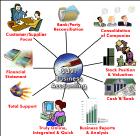Depreciation is the accounting practice of spreading the costs of fixed assets over their useful economic life. Fixed assets are items that a business needs to purchase for long term use, things such as buildings, machinery, equipment, furniture and tools. Depreciation is a non-cash or bank expense that allows for a provision to be made for the replacement of any fixed asset, thus enabling a business to maintain its future operations.
The characteristics of depreciation are:
It is related to depreciable fixed assets only. It is a fall in the book value of a depreciable fixed asset. It is the permanent and continuous decrease in the book value of an asset.
The main causes of depreciation are:
Physical wear and tear over a period of time i.e. over a number of accounting periods. Changes in the economic environment faced by a business. Expiration of legal rights.
The need for charging depreciation in accounting records can arise as a result of any of the following objectives:
To ascertain the true results of the business operations. To ascertain the true cost of production. To present a true and fair view of the financial position of a business. To accumulate funds for replacement of assets. To comply with legal requirements.
To calculate the depreciation charge three important things must first be determined:
The original cost of the asset. An estimate of its economic useful life. An estimate of its residual value.
Depending upon their own preferences, businesses are free to choose from a number of methods when calculating depreciation. Two of the most common methods are as follows:
Straight-Line method – Here the depreciation charge is the same each year.
Amount of depreciation= Original cost-Residual value
Estimated useful life
Reducing Balance method – This is a slightly more complicated but more realistic method of calculating depreciation. When using this method the depreciation charge is higher in the early years when it is thought that most assets lose most of their value.
Annual depreciation= Depreciation rate x Book value at the beginning of each year
Where the book value is the Original cost less the Accumulated depreciation
